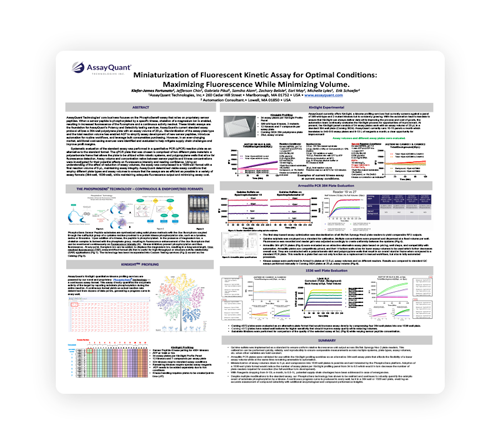Miniaturization of Fluorescent Kinetic Assay for Optimal Conditions: Maximizing Fluorescence While Minimizing Volume
Kiefer-James Fortunato1, Jefferson Chin1, Gabriela Pikul1, Samiha Alam1, Zachary Belisle2, Earl May1, Michelle Lyles1, Erik Schaefer1
1. AssayQuant Technologies, Inc., 260 Cedar Hill Street Marlborough MA 01752 United States of America
2. Automation Consultant, Lowell MA 01850 United States of America

Abstract
AssayQuant Technologies’ core business focuses on the PhosphoSens® assay that relies on proprietary sensor peptides. When a sensor peptide is phosphorylated by a specific kinase, chelation of a magnesium ion is enabled, resulting in increased fluorescence of the fluorophore and a continuous activity readout. These kinetic assays are the foundation for AssayQuant’s Potency and Selectivity testing services. AssayQuant’s current standard assay protocol utilizes a 384-well polystyrene plate with an assay volume of 20 µL. Standardization of the assay plate type and the total reaction volume has enabled AQT to simplify assay development of new sensor peptides, introduce automation for routine workflows, and leverage bulk consumables purchasing. However, in an ever-changing market, additional cost-saving avenues were identified and evaluated to help mitigate supply chain challenges and improve profit margins.
Systematic evaluation of the standard assay was performed in a quantitative PCR (qPCR) reaction plate as an alternative to the standard format. The qPCR plate that was chosen is comprised of two different plate materials: a polycarbonate frame that allows the plate to be utilized within robotic systems, and polypropylene wells that allow for fluorescence detection. Assay volume and concentration ratios between sensor peptide and kinase concentrations were investigated for their potential effects on fluorescence intensity and reading confidence. Using an understanding of the effect of reduction of assay volumes, the assay was compressed to a 1536-well format with a final reaction volume of 5 µL, maintaining assay integrity. AssayQuant determined viable assay conditions that employ different plate types and assay volumes to ensure that the assays are as efficient as possible in a variety of assay formats (384-well, 1536-well), while maintaining adequate fluorescence output and minimizing assay cost.
Key Takeaways
- Quinine sulfate was implemented as a standard to ensure uniform relative fluorescence unit output across BioTek Synergy Neo 2 plate readers. This calibration can be performed quickly, reliably, and reproducibly to ensure comparable measurements across multiple systems, plate types, assay volumes, etc. when other variables are held constant.
- Armadillo PCR plates were validated for use within the KinSight profiling workflow as an alternative 384-well assay plate that affords the flexibility of a lower assay volume while at the same time remaining amenable to automation.
- Miniaturization of assay volumes down to 5 µL and compression into 1536 well plates is possible and well-tolerated by the PhosphoSens platform. Adoption of a 1536-well plate format would reduce the number of assay plates per KinSight profiling panel from 34 to 8.5 which would in turn decrease the number of plate readers required for execution (the full workflow is in development).
- With Reagents dropping from 9-13L a month, to 0.5-1L, potential supply chain shortages have been addressed in case of emergencies.
- Despite multiple modifications to the standard assay, our PhosphoSens technology has shown to be resilient and continues to robustly quantify the catalytic event of substrate phosphorylation by a kinase. A continuous progress curve is produced in every well, be it in a 384 well or 1536 well plate, enabling an accurate assessment of compound selectivity with additional enzymological and compound performance insights.
